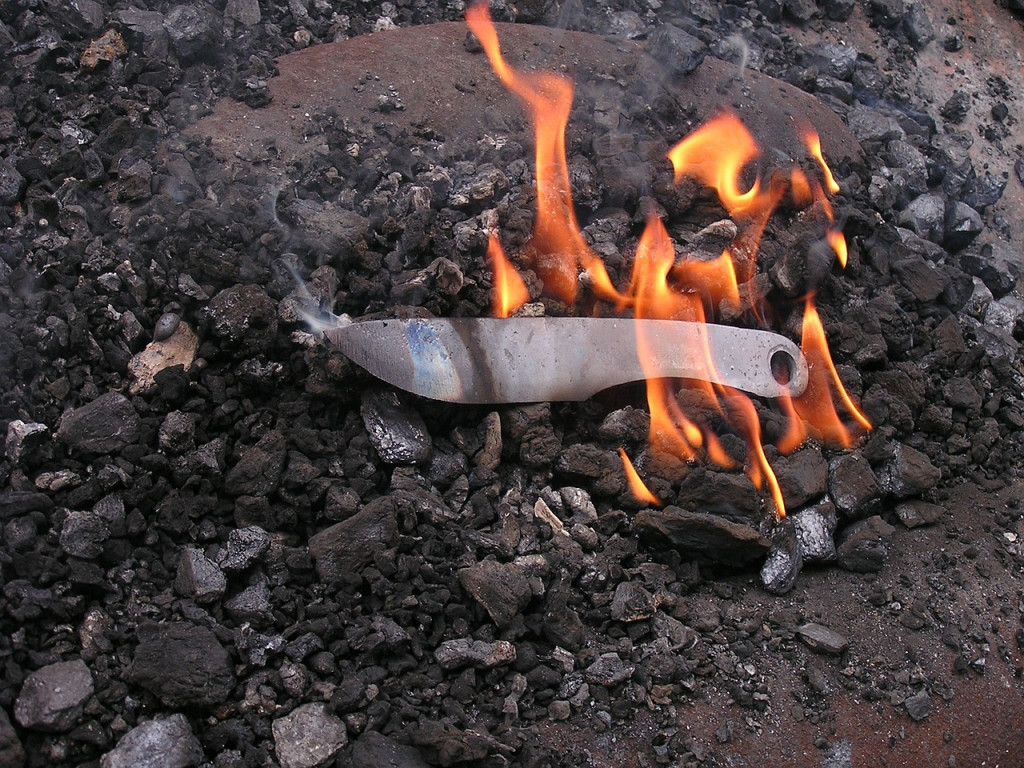If you’re an avid knife enthusiast or a skilled craftsman looking to dive into the world of knife making, then this article is for you. Get ready to discover the powerful tool that is the belt grinder and how it can revolutionize your knife making process. From shaping the blade to sharpening the edge, belt grinders offer precision, control, and efficiency like no other. No more struggling with outdated manual methods – it’s time to equip yourself with the ultimate weapon for creating high-quality knives. So, grab a cup of coffee, sit back, and let’s explore the world of belt grinders for knife making together.

What are Belt Grinders?
Belt grinders are powerful and versatile tools used in knife making and metalworking. They are designed to remove material from the surface of a workpiece, creating a smooth and precise finish by utilizing an abrasive belt that rotates around two or more pulleys. Belt grinders come in various sizes and designs, offering different features and functionality to meet the specific needs of knife makers and metalworkers.
Definition
A belt grinder is a type of grinding machine that utilizes a rotating abrasive belt to remove material from the surface of a workpiece, resulting in a smooth and precise finish.
Components of a Belt Grinder
A belt grinder is composed of several key components that work together to deliver efficient and effective grinding results. These components include:
- Motor: Provides the power necessary to drive the belt and perform the grinding operation.
- Belt: The abrasive belt that wraps around the pulleys and is responsible for removing material from the workpiece.
- Pulleys: The wheels around which the abrasive belt rotates.
- Platen: A flat surface located behind the belt that provides support and stability during the grinding process.
- Tool Rest: A component that holds the workpiece securely in place and allows for precise control during grinding.
- Additional Attachments and Accessories: Optional components that can be added to enhance the versatility and functionality of the belt grinder, such as a sharpening jig, contact wheels, or tooling arms.
Importance of Belt Grinders in Knife Making
Belt grinders play a crucial role in the knife making process, offering several advantages over traditional grinding methods. The following are some of the key reasons why belt grinders are considered essential tools for knife makers.
Precision and Consistency
One of the primary reasons belt grinders are highly valued in knife making is their ability to deliver precise and consistent results. The rotating abrasive belt allows for controlled material removal, ensuring that the ground surfaces are uniform and the desired dimensions are achieved. This level of precision is crucial in creating functional and aesthetically pleasing knives.
Time and Effort Efficiency
Belt grinders are renowned for their efficiency in terms of time and effort. Compared to manual grinding methods, such as hand filing or using a bench grinder, belt grinders significantly reduce the time required to shape and finish a knife. The continuous belt motion and the faster cutting action of the abrasive grit result in quicker material removal, allowing knife makers to increase their productivity.
Versatility in Grinding Options
Another major advantage of belt grinders is their versatility in grinding options. With the ability to easily switch between different abrasive belts, knife makers can achieve a variety of grind profiles and finishes. From flat grinds to hollow grinds, belt grinders provide the flexibility to create different cutting edge geometries and meet the specific requirements of different knife styles and applications.
Types of Belt Grinders
Belt grinders come in various sizes and configurations, each suited for different applications and workspaces. The following are some common types of belt grinders used in knife making:
1×30 Belt Grinder
The 1×30 belt grinder is a compact and budget-friendly option, ideal for beginners or hobbyists. It features a 1-inch wide belt and a 30-inch belt length, making it suitable for small-scale knife making projects. While its smaller size limits its capabilities, the 1×30 belt grinder is still capable of delivering precise and consistent results for basic grinding tasks.
2×42 Belt Grinder
The 2×42 belt grinder is a step up from the 1×30 model, offering improved versatility and power. With a 2-inch wide belt and a 42-inch belt length, it provides a larger grinding surface, allowing for more efficient material removal. The 2×42 belt grinder is popular among knife makers for its ability to handle a wide range of grinding tasks while still being relatively compact and affordable.
2×72 Belt Grinder
Considered the industry standard for professional knife makers, the 2×72 belt grinder offers unparalleled power and versatility. With a 2-inch wide belt and a 72-inch belt length, this grinder provides a substantial grinding area and the ability to tackle even the most demanding projects. The 2×72 belt grinder allows for precise control, making it suitable for creating complex grind profiles and achieving exceptional results.
4×36 Belt Grinder
The 4×36 belt grinder is a larger and more robust option, primarily used in professional metalworking and knife making workshops. With a 4-inch wide belt and a 36-inch belt length, it offers a significant grinding surface and enhanced material removal capabilities. The 4×36 belt grinder is well-suited for heavy-duty grinding tasks and can handle larger workpieces with ease.
Features to Consider when Choosing a Belt Grinder
When selecting a belt grinder for knife making, several features should be taken into consideration. These features will determine the grinder’s performance and suitability for specific tasks. Here are the key features to consider:
Motor Power and Speed
The motor’s power and speed play a crucial role in determining the grinding performance of the belt grinder. A more powerful motor provides greater cutting force, allowing for faster and more efficient material removal. Additionally, variable speed control allows for better control over the grinding process, enabling knife makers to adjust the speed according to their specific needs.
Belt Size and Type
Belt size and type are essential considerations as they determine the grinding area and the specific applications the grinder can handle. Wider belts offer larger grinding surfaces and are better suited for heavy material removal, while narrower belts provide more precision for intricate grinding tasks. The choice of belt type, such as ceramic, aluminum oxide, or zirconia, depends on the desired finish and the material being ground.
Adjustability and Belt Tracking
An adjustable belt tracking mechanism is crucial for ensuring the belt stays centered and aligned during operation. It allows for precise adjustment to achieve optimal belt tension and alignment, preventing uneven or excessive wear. Belt tracking ensures consistent grinding results and extends the life of the abrasive belt.
Platen and Tool Rest
The platen, a flat surface behind the belt, provides support and stability during grinding. An adjustable platen allows for different grinding angles and positions, providing versatility in grind profiles. Additionally, a robust and adjustable tool rest is essential for securely holding the workpiece and facilitating precise control during grinding.
Additional Attachments and Accessories
Some belt grinders come with additional attachments and accessories that enhance their functionality and versatility. These can include contact wheels of different sizes for achieving various grind profiles, sharpening jigs for precise blade sharpening, or tooling arms for mounting additional grinding or polishing attachments. Consider the availability of these optional components and their compatibility with the chosen belt grinder.
Safety Precautions when Using Belt Grinders
As with any power tool, safety should always be a priority when using belt grinders. The following safety precautions should be followed to ensure a safe working environment:
Wear Proper Protective Gear
When operating a belt grinder, always wear appropriate protective gear, including safety glasses or a face shield to protect against flying debris, hearing protection to guard against noise, and gloves to shield your hands from the abrasive belt and workpiece.
Secure Workpiece and Maintain Control
Ensure the workpiece is securely held in place and properly supported during grinding to prevent it from becoming dislodged or spinning out of control. Use clamps or fixtures to secure the workpiece, allowing for safe and controlled grinding.
Monitor and Maintain Equipment
Regularly inspect the belt grinder for any signs of damage or wear, such as frayed belts, loose pulleys, or damaged electrical cords. If any issues are identified, address them immediately before further use. Additionally, keep the grinder clean and free from debris that can affect its performance.
Proper Handling and Storage
When not in use, store the belt grinder in a safe and secure location, away from children and other unauthorized users. Always handle the grinder with care, ensuring the power is switched off and the abrasive belt has come to a complete stop before making any adjustments or changes.
Setting up and Using a Belt Grinder
Proper setup and operation of a belt grinder are essential for achieving optimal grinding results. The following steps will guide you through the process:
Assembly and Installation
- Read and understand the manufacturer’s instructions and safety guidelines before assembling the belt grinder.
- Ensure all necessary components and accessories are available and in good working condition.
- Assemble the grinder according to the manufacturer’s instructions, following proper wiring and belt installation procedures.
- Position the grinder in a well-ventilated and well-lit workspace, ensuring there is enough clearance and space for safe operation.
Grinder Operation and Techniques
- Familiarize yourself with the grinder’s controls and safety features before starting the grinder.
- Ensure the workpiece is securely clamped or fixtured in place and properly aligned with the grinding belt.
- Switch on the grinder and adjust the belt speed to the desired setting, considering the type of material being ground and the specific grinding task.
- Hold the workpiece firmly against the abrasive belt, applying consistent pressure and maintaining control throughout the grinding process.
- Move the workpiece against the direction of the belt rotation to achieve effective material removal, taking care not to apply excessive force that can lead to overheating or unwanted curvature.
- Pay attention to the grinding progress, periodically inspecting the workpiece and adjusting the grinding technique if needed.
- After grinding, switch off the grinder, ensuring the belt has come to a complete stop before removing the workpiece or making any adjustments.
Maintaining and Troubleshooting
To ensure the longevity and optimal performance of your belt grinder, regular maintenance and troubleshooting are necessary. Follow these guidelines:
- Regularly inspect the grinder, belts, and components for signs of wear and damage. Replace any worn or damaged parts immediately to prevent further issues.
- Clean the grinder after each use to remove any debris or residue that can affect its performance.
- Lubricate any moving parts as recommended by the manufacturer to ensure smooth operation.
- If you encounter any issues or abnormalities during grinding, consult the manufacturer’s troubleshooting guide or contact customer support for assistance.
Tips for Achieving Optimal Results with Belt Grinders
To achieve the best possible results when working with a belt grinder, consider the following tips:
Selecting the Right Grit and Belt Type
Choosing the appropriate grit size and belt type is essential for achieving the desired finish. Coarser grits are ideal for heavy material removal, while finer grits produce a smoother finish. Additionally, select the belt type that is best suited for the material being ground, such as ceramic for hard steels or aluminum oxide for softer metals.
Maintaining Proper Belt Tension
Proper belt tension is crucial for efficient grinding and extended belt life. Ensure the belt is tensioned correctly, neither too loose nor too tight, to prevent slipping or excessive wear. Refer to the manufacturer’s guidelines for the recommended tensioning method.
Techniques for a Smooth and Even Grind
When grinding, maintain a steady and even pressure on the workpiece, moving it smoothly against the abrasive belt. Avoid jerky or uneven movements that can result in an uneven grind or unwanted curvature.
Avoiding Heat Build-up
Heat buildup during grinding can lead to tempering or overheating of the workpiece, affecting its hardness or causing warping. Use light and frequent passes instead of prolonged grinding to prevent excessive heat buildup and monitor the workpiece’s temperature throughout the process.
Common Mistakes to Avoid in Belt Grinding
To ensure satisfactory grinding results, be mindful of the following common mistakes and avoid them:
Inconsistent Pressure and Angle
Applying inconsistent pressure or grinding at inconsistent angles can result in an uneven grind profile or unnecessary material removal. Maintain a consistent and firm pressure on the workpiece, ensuring it remains in contact with the abrasive belt at all times.
Excessive Material Removal
Removing too much material in a single pass or applying excessive force can lead to uneven surfaces, overheating, or even damage to the workpiece. Instead, opt for gradual and controlled material removal, allowing the abrasive belt to do the work efficiently.
Improper Cooling and Lubrication
For certain grinding tasks, it may be necessary to use coolant or lubricant to prevent overheating and maintain the quality of the grinding surface. Failure to lubricate or cool the workpiece adequately can result in decreased grinding performance and compromised finish quality. Follow the manufacturer’s recommendations for cooling and lubrication if applicable.
Advanced Techniques for Belt Grinding
Once you have mastered the basics of belt grinding, you may wish to explore more advanced techniques to achieve specific grind profiles. Some of these techniques include:
Hollow Grinding
Hollow grinding involves creating a concave grind profile, resulting in a thin and sharp cutting edge. This technique is commonly used in knife making to enhance cutting performance and reduce overall blade weight.
Scandi Grind
The Scandi grind, also known as the Scandinavian grind or zero grind, is a flat grind that starts from the spine of the blade, meeting the cutting edge in a single bevel. It is a popular grind style for outdoor and bushcraft knives, offering excellent slicing performance and durability.
Convex Grind
A convex grind features a convex curve along the blade’s edge, creating a strong and robust cutting edge. This grind style is commonly used in heavy-duty knives and provides increased durability and resistance to chipping.
Resources for Belt Grinders and Knife Making
To further enhance your knowledge and skills in belt grinders and knife making, consider exploring the following resources:
Reliable Brands and Manufacturers
Research reputable brands and manufacturers of belt grinders to find high-quality and reliable products. Some well-known brands include Burr King, Kalamazoo Industries, Grizzly Industrial, and Hardcore Grinders.
Online Communities and Forums
Join online knife making communities and forums where experienced knife makers and metalworkers share their expertise, tips, and techniques. These platforms provide an opportunity to learn from others, ask questions, and receive valuable feedback.
Educational Books and Videos
Invest in educational books or watch instructional videos on knife making and belt grinding. These resources often cover various topics, including grinder setup, grinding techniques, and advanced grinding methods. Some popular titles and channels include “The Complete Bladesmith” by Jim Hrisoulas and various videos from knife making channels such as “Walter Sorrells” and “Green Beetle.”
In conclusion, belt grinders are essential tools in the world of knife making and metalworking. They offer precise and consistent grinding results, time and effort efficiency, and versatile grinding options. When choosing a belt grinder, consider important features such as motor power and speed, belt size and type, adjustability, and additional attachments. It is crucial to prioritize safety by wearing proper protective gear, securely holding the workpiece, and regularly maintaining and inspecting the grinder. By following proper setup and operation techniques, utilizing optimal grinding tips, and avoiding common mistakes, knife makers can achieve optimal results and enhance their skills. Remember to explore advanced grinding techniques and utilize available resources, such as reputable brands, online communities, and educational materials, to continue learning and improving in the art of belt grinding and knife making.



